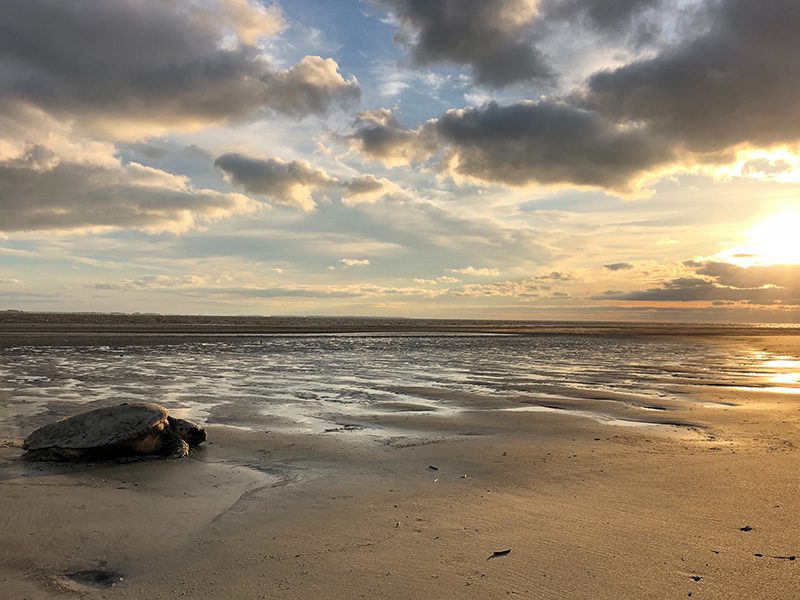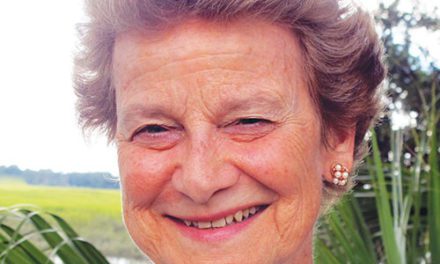These sea turtle volunteers go above and beyond.

Sue Dressler, Tami Conner, and Abby Morris, volunteers who protect and monitor the sea turtle nests of Pritchard’s and Little Capers Islands
Every year, over 1,100 South Carolinians commit their summers to protecting and monitoring the nesting activity of sea turtles on our beaches from May to October. Of them, 16 dedicated volunteers truly go above and beyond the call of ordinary sea turtle patrol duty in Beaufort County. They are they sea turtle volunteers of Pritchard’s and Little Capers Islands.
These two barrier islands on the fringe of the Atlantic are wild, uninhabited, and only accessible by boat, during a specific tidal window. They are wilderness nesting homes for threatened loggerhead sea turtles, although the occasional endangered variety of sea turtle is also reported. Incidentally, Pritchard’s Island is one of Beaufort County’s most nested beaches, with 108 nests last year.
Its remoteness creates a number of logistical challenges for the small group of volunteers. For one, you need a boat and a captain. Some of the volunteers will kayak across Skull Inlet from Fripp Island. Barring dangerous weather and sea conditions, two to four people will go out every day for six months, rotating amongst their 16 core members.
Two: All tools required to protect, mark, and relocate nests must be boated to, stored on, and lugged down the islands. All bags of trash collected must go along for the ride back.
Three: You’re on nature’s schedule when working at the whim of the tides. The timing of sunlight hours in combination with the tide must be impeccable, or else risk getting your boat stranded on the beach. Sometimes this happens anyways. Also, Little Capers, the furthest island of the two from civilization, has two inlets dividing its beach that are impassable outside of low tide.
For all three reasons above, it’s difficult to arrive at dawn like most sea turtle teams along the eastern seaboard and the Gulf Coast. This means that the team rarely encounters the night-nesting mothers whose nests they toil to protect.

A loggerhead sea turtle on the beach
And the sweltering mid-summer heat and humidity of the South, and scorching sand temperatures over 100 degrees? You got it. That doesn’t stop this group either.
“I think it requires a little bit of masochism,” says Tami Conner, one of the Pritchard’s Island sea turtle volunteers. “You have to be okay with suffering a little to fulfill your commitment to what you believe is doing right by the environment and by the turtles.”
Tami joins her turtle teammates, volunteer Sue Dressler and ringleaders Abby and Robert Morris, at the Station Creek boat launch for their pontoon pilgrimage. With a smile on their faces, Abby and Robert Morris make their ritual commute at high tide through the Lowcountry’s snaking estuaries to Pritchard’s Island, as they have for the last 10 years. Yelling across the droning engine and whipping wind, I ask the Morris’ why they do what they do.
“Well, because we love it,” Abby says, looking back at her husband Robert and laughing together.
“There was a need,” Robert says, “and Abby thought we could do it.”
“I knew we could do it,” she follows up.
Abby Morris began organizing Pritchard’s sea turtle conservation and DNA sampling efforts in 2011, and later Little Capers Island’s, too. Or, as her husband Robert puts it, “She filled the void when the university left.”
Pritchard’s Island was donated to the University of South Carolina Beaufort in 1982 by an Atlanta businessman named Philip Rhodes. Rhodes had one condition, that the island’s pristine ecosystem be conserved and used only for research purposes. Today, many only recognize the island by the photos of its dilapidated research center half swallowed by the sea. The torch of its sea turtle conversation and research efforts—as well as the island’s saving grace from development—now rests in the hands of Abby Morris and her dedicated team of citizen scientists.
It helps that Abby’s counterpart, Robert Morris, is a U.S. Coast Guard certified boat captain. Robert grew up in Beaufort and spent many formative days at his family’s fish camp on Pritchard’s Island, the only active camp remaining. Robert can even recall a time when the same eggs he now protects were occasionally used for baking—completely legal to do back in the day. The “conservationist in training,” as he’s sometimes jokingly called, is now quite the pro at finding, sometimes difficult to locate, egg chambers.
It was one day strolling the beach that Abby discovered a carnage of sea turtle eggs leftover from racoons, the island’s biggest predator, and decided to re-start Pritchard Island’s sea turtle conservation efforts. She persuaded SCDNR to give her a permit to be a part of the state’s loggerhead DNA sampling effort. For Abby, some data was better than none.

Volunteers Robert and Abby Morris
Thanks to this data, scientists and volunteers alike are able to track individual mothers who return or visit new beaches in their natal nesting region, such as “Mama Pritchard,” the island’s most reliable nesting mother. They can also track emerging patterns and trends across states, like that the number of sea turtle nests along Beaufort County’s beaches are increasing.
This trend of increasing nests coincides with the introduction of federal regulation in the 90s requiring the use of turtle exclusion devices on commercial fishing nets, and the fact that it takes sea turtles 20 to 30 years to mature reproductively.
“Turtles that were hatched 30 years ago are now coming back to our beach in greater numbers in large part due to the fact that shrimpers now have a cleaner catch because they’re using turtle excluder devices,” says Jan Grimsley, who helps spearhead nearby Harbor Island’s sea turtle conservation team. “It is due to the efforts of volunteers who protect these nests and to pioneers, like Sally Murphy, who lobbied for the use of turtle excluder devices.”
But this isn’t the only trend Abby notices. “Because of higher tides and bigger storms and all that, we’re losing nests to weather. When we first started out here, we didn’t do any relocation.”

Remnants of USC’s research center on Pritchard’s Island
She points to a sand bank bordered by an elevated maritime forest as far as the eye can see. Even to the non-turtler, it’s clearly the end of the road for any sea turtle. “Any of them that nest through here,” she says, “we’ll have to relocate them, and that makes for a real challenge. The high tides and King tides go all the way to the bank.”
These graceful sea swimmers only come on land for one reason: to nest three to six times in one season, often without wood, every two to three years. Their vision is blurry, and their organs compress out of the water. It’s a long haul to crawl high enough on the beach where nests will be safe from sweeping high tides or saltwater intrusion, which rots the eggs.
“You get some turtles and it’s like they bump one thing, and they back up and bump another one. They start digging a hole and then they hit roots. I mean sometimes it’s like, ‘Oh my god, I’m exhausted just looking at what it would be like to drag yourself through all this,’” says Abby.
Relocating nests from these areas is a meticulous time-consuming task for volunteers who have to do it in a timely and precise fashion. Sometimes when there’s eight nest and a tide to catch. Sometimes when it feels like it’s 100 degrees.
“When I think of the sacrifices and the hard work of being a mother sea turtle, it makes our sacrifices to help them feel worth it,” says Tami Conner. “It comes out of that love.”








